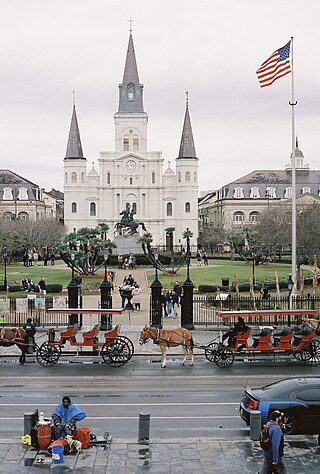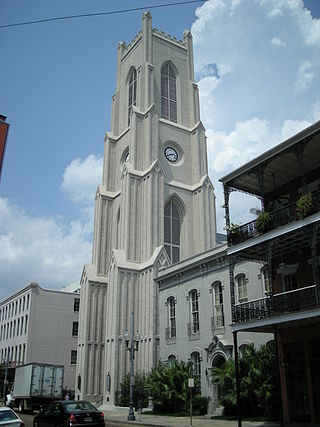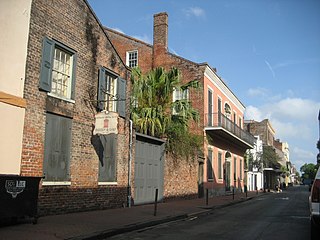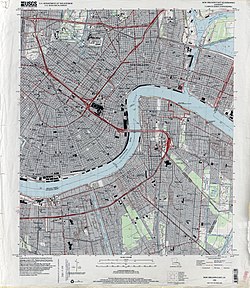
The French Quarter, also known as the Vieux Carré, is the oldest neighborhood in the city of New Orleans. After New Orleans was founded in 1718 by Jean-Baptiste Le Moyne de Bienville, the city developed around the Vieux Carré, a central square. The district is more commonly called the French Quarter today, or simply "The Quarter", related to changes in the city with American immigration after the 1803 Louisiana Purchase. Most of the extant historic buildings were constructed either in the late 18th century, during the city's period of Spanish rule, or were built during the first half of the 19th century, after U.S. purchase and statehood.

The Garden District is a neighborhood of the city of New Orleans, Louisiana, United States. A subdistrict of the Central City/Garden District Area, its boundaries as defined by the New Orleans City Planning Commission are: St. Charles Avenue to the north, 1st Street to the east, Magazine Street to the south, and Toledano Street to the west. The National Historic Landmark district extends a little farther.

Jackson Square, formerly the Place d'Armes (French) or Plaza de Armas (Spanish), is a historic park in the French Quarter of New Orleans, Louisiana. It was declared a National Historic Landmark in 1960, for its central role in the city's history, and as the site where in 1803 Louisiana was made United States territory pursuant to the Louisiana Purchase. In 2012 the American Planning Association designated Jackson Square as one of the Great Public Spaces in the United States.

The Morris–Butler House is a Second Empire-style house built about 1864 in the Old Northside Historic District of Indianapolis, Indiana. Restored as a museum home by Indiana Landmarks between 1964 and 1969, the American Civil War-era residence was the non-profit organization's first preservation project. Restoration work retained some of its original architectural features, and the home was furnished in Victorian and Post-Victorian styles. Its use was changed to a venue for Indiana Landmarks programs, special events, and private rentals following a refurbishment in 2013. Regular daily tours of the property have been discontinued.

Gallier Hall is a historic building on St. Charles Avenue in New Orleans, Louisiana. It is the former New Orleans city hall, and continues in civic use. Built 1845–1853, it is a nationally significant example of Greek Revival architecture, and one of the finest works of architect James Gallier. It was designated a National Historic Landmark in 1974.

James Gallier was a prominent nineteenth-century Irish-born American architect, most famed for his buildings in New Orleans. Gallier Hall, which he designed and once served as New Orleans City Hall, is named after him.

The Old Louisiana State Capitol, also known as the State House, is a historic government building, and now a museum, at 100 North Boulevard in Baton Rouge, Louisiana, U.S. It housed the Louisiana State Legislature from the mid-19th century until the current capitol tower building was constructed from 1929-32.

St. Patrick's Church is a Catholic church and parish in the Archdiocese of New Orleans, Louisiana, United States. The parish was founded in 1833, and the current structure was completed in 1840. It is the second-oldest parish in New Orleans, located upriver from the French Quarter at 724 Camp Street in what is now the Central Business District. The building, a National Historic Landmark, is one of the nation's earliest and finest examples of Gothic Revival architecture.

The buildings and architecture of New Orleans reflect its history and multicultural heritage, from Creole cottages to historic mansions on St. Charles Avenue, from the balconies of the French Quarter to an Egyptian Revival U.S. Customs building and a rare example of a Moorish revival church.

Rosedown Plantation State Historic Site is an 8,000-square-foot (740 m2) historic home and former plantation located in St. Francisville, Louisiana, United States. Built in 1835 by Daniel and Martha Turnbull, it is one of the most documented and intact plantation complexes in the Southern United States. It is known for its extensive formal gardens surrounding the house.

The Napoleon House, also known as the Mayor Girod House or Nicolas Girod House, is a historic building at 500 Chartres Street in the French Quarter of New Orleans, Louisiana, United States. Built in 1794 and enlarged in 1814, its name derives from the local legend that it was intended as a residence for Napoleon Bonaparte after his exile. A plan to bring Napoleon to Louisiana was halted by news of his death in 1821.
James Gallier Jr., was a prominent architect in New Orleans, Louisiana. His father, James Gallier was also a New Orleans architect.

The Hermann–Grima House is a historic house museum in the French Quarter of New Orleans, Louisiana, United States. The meticulously restored home reflects 19th century New Orleans. It is a Federal-style mansion with courtyard garden, built in 1831. It has the only extant horse stable and 1830s open-hearth kitchen in the French Quarter.

Louisiana State Bank Building is a historic commercial building at Royal and Conti Streets in the French Quarter of New Orleans, Louisiana. Built in 1820, it was the last structure designed by nationally prominent architect Benjamin Henry Latrobe, who died from yellow fever in New Orleans before its construction. It has also been known as the Manheim Galleries building, from a long-time tenant. More recently, it has housed "Latrobe's", an event venue. It was declared a National Historic Landmark in 1983.

Madame John's Legacy is a historic house museum at 632 Dumaine Street in the French Quarter of New Orleans, Louisiana. Completed in 1788, it is one of the oldest houses in the French Quarter, and was built in the older French colonial style, rather than the more current Spanish colonial style of that time. It was declared a National Historic Landmark in 1970 for its architectural significance. The Louisiana State Museum owns the house and provides tours.

The Pontalba Buildings form two sides of Jackson Square in the French Quarter of New Orleans, Louisiana. They are matching red-brick, one-block-long, four‑story buildings built between 1849–1851 by the Baroness Micaela Almonester Pontalba. The ground floors house shops and restaurants; and the upper floors are apartments which, reputedly, are the oldest continuously-rented such apartments in the United States.

Ursuline Convent was a series of historic Ursuline convents in New Orleans, Louisiana, United States. In 1727, at the request of Governor Étienne Perier, nuns from the Ursuline Convent of Rouen (Normandy) went to New Orleans to found a convent, run a hospital, and take care of educating young girls.

The Louisiana State Museum's 1850 House is an antebellum row house furnished to represent life in mid-nineteenth-century New Orleans. It is located at 523 St. Ann Street on Jackson Square in the French Quarter.

The Bank of Louisiana building is located at 334 Royal Street in the French Quarter of New Orleans, Louisiana. It was added to the National Register of Historic Places in 1973.
The Malus-Beauregard House, previously known as the Rene Beauregard house, is a home built in 1832-1833 and significantly altered in 1850's to a Greek Revival style overlooking the Battle of New Orleans battlefield. Located in St. Bernard Parish about 6 miles east of the City of New Orleans and adjoining the field of Chalmette where the Battle of New Orleans was fought in 1815. The house is named after its first and last owners and served as a country residence for several wealthy families during the 19th century. Its latest use was the Visitor's Center for the Chalmette Battlefield but has been closed since Hurricane Katrina due to its poor condition. It is not considered of historical importance due to it being located on the famous battlefield but unrelated and built after the event. No restoration efforts are planned.






















